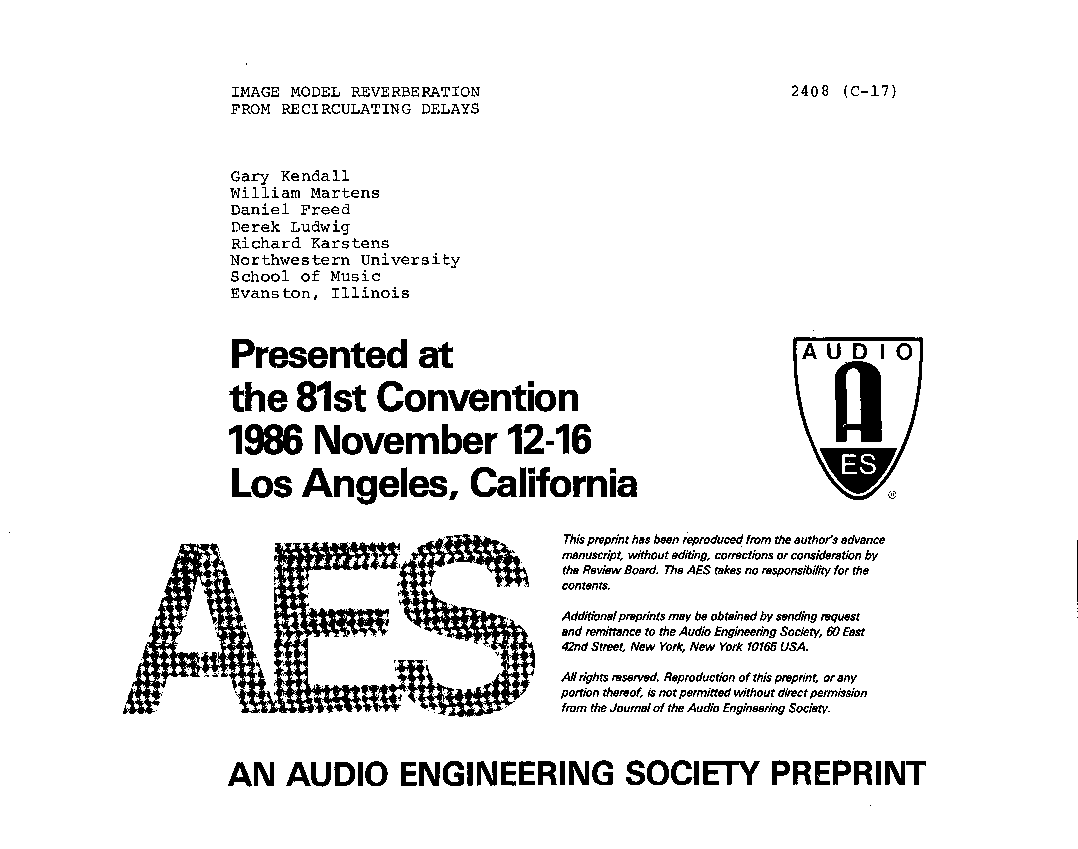Home / Publications / E-library page
You are currently logged in as an
Institutional Subscriber.
If you would like to logout,
please click on the button below.
Home / Publications / E-library page
Only AES members and Institutional Journal Subscribers can download
The technique of recirculating delays has served as the basis for reverberation simulation in digital audio production ever since the publication of Manfred Schroeder`s pioneering work in 1962. The Schroeder reverberator prescribes small units of recirculating delays in a configuration that is predominantly serial. Extensions to this method by Chowning (1970) and Moorer (1979) have achieved substantial improvements in realism and naturalness, while maintaining the basic structure of the Schroeder model. These and other contemporary approaches to reverberation attempt to replicate the global reverberation typical of large reverberant rooms like concert halls without attempting to capture any of the exact characteristics that distinguish one room from another. Since these methods do not actually model a room, matching the reverberation to the characteristics of a particular room is largely a matter of guesswork. The "image model" of reverberation (Allen and Berkeley, 1979) provides a method for predicting both the spatial and the temporal pattern of reflected sound from the room dimensions and the positions of the sound source and the listener within the room. Until now, the image model was computationally too expensive for use in audio and music production since it could only be implemented by convolution with an entire simulated room impulse response. In the process of creating the "spatial reverberation" technique, Kendall and Martens (1984) devised a reverberation network with recirculating delays that captures the spatial and temporal distribution of reflected sound predicted by the image model. The network consists of recirculating delay units that are connected entirely in parallel with non-recirculating cross feeding. The "reverberation stream" produced by each unit captures the temporal pattern of reflected sound from a specific region of the room. The ensemble of reverberation streams produced by the entire network captures the spatial and temporal pattern reflected sound predicted by the image model. The output of the reverberator may be mixed to mono, lateralized to stereo, or spatialized into three dimensions as "spatial reverberation." Experience using the reverberator has shown that it is capable of achieving a high degree of realism with both large and small simulated rooms as well as creating vivid illusions of source distance.
Author (s): Kendall, Gary; Martens, William; Freed, Daniel; Ludwig, Derek; Karstens, Richard
Affiliation:
Northwestern University, School of Music, Evanston, IL
(See document for exact affiliation information.)
AES Convention: 81
Paper Number:2408
Publication Date:
1986-11-06
Import into BibTeX
Session subject:
Audio Recording and Signal Processing
Permalink: https://aes2.org/publications/elibrary-page/?id=5022
(827KB)
Click to purchase paper as a non-member or login as an AES member. If your company or school subscribes to the E-Library then switch to the institutional version. If you are not an AES member Join the AES. If you need to check your member status, login to the Member Portal.

Kendall, Gary; Martens, William; Freed, Daniel; Ludwig, Derek; Karstens, Richard; 1986; Image Model Reverberation from Recirculating Delays [PDF]; Northwestern University, School of Music, Evanston, IL; Paper 2408; Available from: https://aes2.org/publications/elibrary-page/?id=5022
Kendall, Gary; Martens, William; Freed, Daniel; Ludwig, Derek; Karstens, Richard; Image Model Reverberation from Recirculating Delays [PDF]; Northwestern University, School of Music, Evanston, IL; Paper 2408; 1986 Available: https://aes2.org/publications/elibrary-page/?id=5022